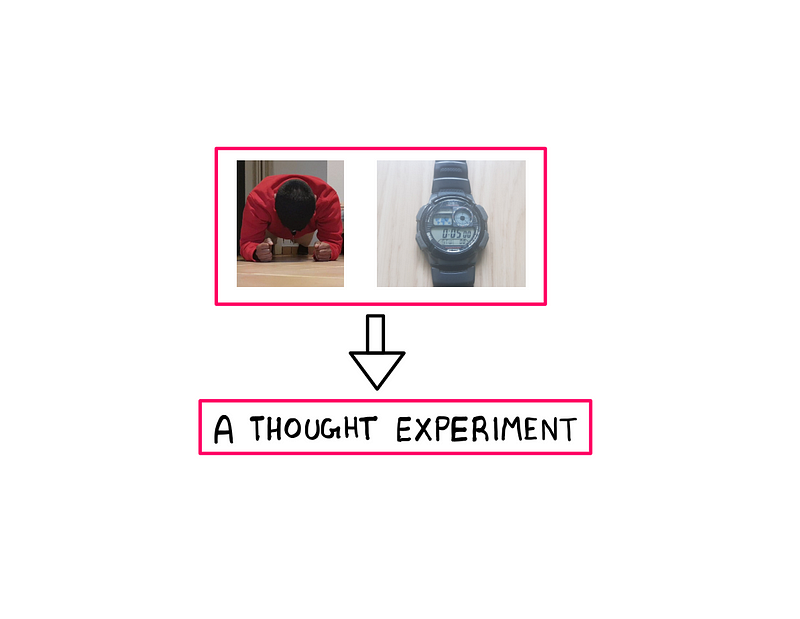Exploring Entropy: The Five-Minute Plank Challenge
Written on
Chapter 1: The Plank Challenge
Six years ago, I embarked on a demanding hobby: The Five-Minute Plank. The objective is straightforward: perform a five-minute plank every morning. However, executing this task proved to be quite a formidable challenge for me.
Initially, I struggled to hold the plank for even a minute. Gradually, I built up my endurance, and after a year of dedicated effort, I finally managed to sustain the plank for the full five minutes. Today, this “challenge” has transformed into a daily routine for me, rather than a test of willpower. Yet, this narrative is not solely about my plank practice; it also touches on a peculiar habit that I developed along the way—my obsession with the stopwatch.

Chapter 2: The Stopwatch Obsession
My aim each morning extends beyond merely holding a plank for five minutes; I strive to stop the stopwatch precisely at 05:00:00 (including centiseconds). While this may seem trivial to many, it captivates my interest.
I find myself contemplating what motivates individuals to engage in such seemingly pointless behaviors. Is there more significance behind it? As my fascination grew, I began to explore this concept through the lens of entropy.
Section 2.1: A Simple Probability Analysis
Looking at my stopwatch from today’s attempt, I can see how challenging this goal truly is.

The stopwatch features two centisecond digits, yielding 100 possible values (00 through 99) in each second. My objective is to stop the timer at an exact 05:00:00. Ignoring human factors, if we assume each centisecond has an equal chance, the probability of stopping at 05:00:00 is:
P(05:00:00) = 1/100 = 0.01 (or 1%).
This calculation is an oversimplification, but it serves as a starting point. If we consider human reaction time, typically around 250 milliseconds (or 25 centiseconds), along with variability in button presses, the real probability of achieving 05:00:00 becomes even more complex, likely dropping below 1%.
Section 2.2: Habits and Entropy
While calculating the exact entropy reduction is complex, I can qualitatively represent it. Each time I successfully stop the stopwatch at 05:00:00, I am reducing the local entropy of the system. However, according to established physical laws, this action likely increases entropy elsewhere. Thus, I am locally decreasing entropy while globally increasing it.
Chapter 3: The Thermodynamics of Living Systems
My exploration of entropy encompasses both thermodynamic and informational perspectives. This time, I lean towards the thermodynamic viewpoint.
When I focus on stopping the stopwatch at 05:00:00, specific neurons in my brain activate, and my grip on the watch becomes crucial. If my grip falters, my chance of achieving the desired outcome diminishes. Engaging in this task expends energy, leading to increased heat output to the environment when I achieve the target time compared to more common outcomes like 04:99:99 or 05:00:01.
The first video, "Entropic Gravity from Quantum Entanglement! | with Erik Verlinde," delves into the relationship between entropy and gravity, exploring how these concepts intertwine in our understanding of the universe.
Chapter 4: The Thermodynamics of Non-living Systems
As I refine my technique, the wear on my watch becomes apparent. Each precise stop at 05:00:00 causes slight degradation of the watch's components, including the button mechanism and sensors. These interactions also generate heat, just like my own bodily processes.
The second video, "Erik Verlinde: Entropic Gravity, Black Holes, and the Holographic Principle | RP#159," further explores these themes, discussing the implications of entropy in black hole physics and the universe's structure.
Section 4.1: Closing Thoughts
Through my “silly” thought experiment, I reaffirm a fundamental observation: there is no free lunch.
When we engage in productive activities, we decrease local entropy while simultaneously increasing it globally. For instance, traveling from point A to point B in a car is productive work, yet it relies on burning fuel, a lower entropic resource. This process ultimately raises global entropy.
In essence, while local entropy may decrease due to our efforts, the total entropy of the system and its surroundings still climbs. The beauty lies in the benefits we derive from reducing local entropy within our limited lifetimes.